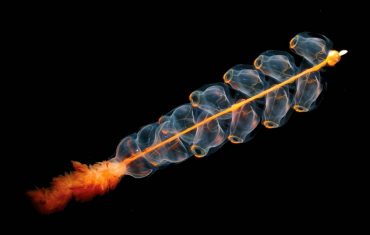
(Photo Credit: Hidden Ocean Expedition 2005/NOAA/OAR/OER)
Do you like to walk our beautiful Puget Sound beaches at low tide? Do you slowly stroll up and down the docks, staring into the water to catch a glimpse of the sea life lurking beneath the depths?
If you do this with any regularity, you are probably familiar with the usual intertidal suspects such as shore crabs, sea stars, various shellfish, anemones and feather duster tubeworms. But occasionally, if you keep exploring, you may be surprised by what looks back.
You might be surprised to observe a creature that is providing inspiration to engineers working on underwater vehicle design. You might be surprised to see a creature that exhibits a surprisingly high degree of complex colony behavior. You might be surprised to be looking at a group of animals, not an individual.
The siphonophore might look like a piece of broken jellyfish, but what a thrill when I saw this translucent blob start to zip through the water. It moved surprisingly fast, utilizing a multi-jet swimming system to hunt its prey. The siphonophore is a predatory colonial hydrozoa, composed of individual zooids that are attached together and work remarkably well as a colony functioning as one animal.
The zooids differentiate to perform a variety of specific tasks. The “head” region is composed of Nectophore zooids. The young Nectophores steer the organism, while the mature Nectophores create the thrust for movement.
The Nectophores work so efficiently that researchers are studying their method of propulsion to help improve underwater vehicle design. The “tail” region, called the “Siphosome,” contains the zooids responsible for feeding and reproduction. This tiny collective of jelly-like zooids made me wonder about how much we, human beings, do on our own.
The siphonophore is a clear example of a cooperative colony with each member taking on a defined role, but how does the siphonophore relate to human beings? We pride ourselves on our individuality, but could we really go it alone?
We could not effectively digest our food or utilize the nutrients without a variety of bacteria residing in our intestines. Our skin and dental health are also maintained by a variety of bacteria. At the very core of all life, except the most primitive, is an ancient symbiotic relationship between cells and bacteria where the bacteria eventually became mitochondria.
The mitochondrion is the part of each of our cells responsible for energy production. The human body has 10 times more bacterial cells than human cells, which has led some scientists to label us as “superorganisms.
And the idea that bacteria are more than just pathogens has led the National Institutes of Health to form the Human Microbiome Project in 2008 to document the bacteria that call humans home. It seems that colonial arrangements in the animal world are not just for invertebrates anymore.
Extend the collective metaphor beyond ourselves to our families, communities and countries. From a distance, we too, are a siphonophore. We all have designated roles and provide to a whole larger than ourselves.
But unlike the siphonophore, our roles are not defined at birth. With education and reflective thought, we can choose where and how we interact with society. And like the Nectophores, we can adjust our roles in society as we mature.
The beauty of getting outside for a walk on the beach or through the forest is the new lens that we can use to peer back at ourselves. And this is why I am so curious about the tiny siphonophore, because sometimes something so small can be grandly magnificent.
To learn more about siphonophores and other bizarre and beautiful animals of the Puget Sound, please visit harborwildwatch.org and subscribe to the newsletter. Or become a Harbor WildWatch Steward Club member and help share our amazing natural world with your community.
Harbor WildWatch is a 501(c)(3) nonprofit environmental education organization based in Gig Harbor. Its mission is to inspire stewardship for Puget Sound by providing learning opportunities about the environment to the people in the local community. Through more than 600 fun and interactive programs each year, Harbor WildWatch hopes to inform residents and visitors about local marine life and elicit their involvement in preserving our natural resources.
























